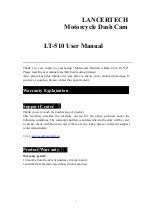
AirLive
POE100CAMv2
User’s
Manual
126
Chapter 9 Glossary
ActiveX -
A standard that enables software components to interact with one another in a networked environment,
regardless of the language(s) used to create them. Web browsers may come into contact with ActiveX
controls, ActiveX documents, and ActiveX scripts. ActiveX controls are often downloaded and installed
automatically as required.
AF (Autofocus) -
A system by which the camera lens automatically focuses on a selected part of the subject.
Angle -
The field of view, relative to a standard lens in a 35mm still camera, expressed in degrees, for example,
30°. For practical purposes, this is the area that a lens can cover, where the angle of view is determined
by the focal length of the lens. A wide-angle lens has a short focal length and covers a wider angle of
view than standard or telephoto lenses, which have longer focal lengths.
ARP (Address Resolution Protocol) -
This protocol is used to associate an IP address to a hardware MAC address. A request is broadcast on
the local network to discover the MAC address for an IP address.
ASIC (Application Specific Integrated Circuit) -
A circuit designed for a specific application, as opposed to a general purpose circuit, such as a
microprocessor.
Aspect ratio -
A ratio of width to height in images. A common aspect ratio used for television screens and computer
monitors is 4:3. High-definition television (HDTV) uses an aspect ratio of 16:9.
Autoiris (or DC-Iris) -
This special type of iris is electrically controlled by the camera, to automatically regulate the amount of
light allowed to enter.
AVI (Audio Video Interleave) -
A video format that supports simultaneous playback of audio and video.
Bitmap -
A bitmap is a data file representing a rectangular grid of pixels. It defines a display space and color for
each pixel (or "bit") in the display space. This type of image is known as a "raster graphic." GIF and
JPEG are examples of image file types that contain bitmaps.
Because a bitmap uses this fixed raster method, it cannot easily be rescaled without losing definition.
Conversely, a vector graphic image uses geometrical shapes to represent the image, and can thus be
quickly rescaled.












































